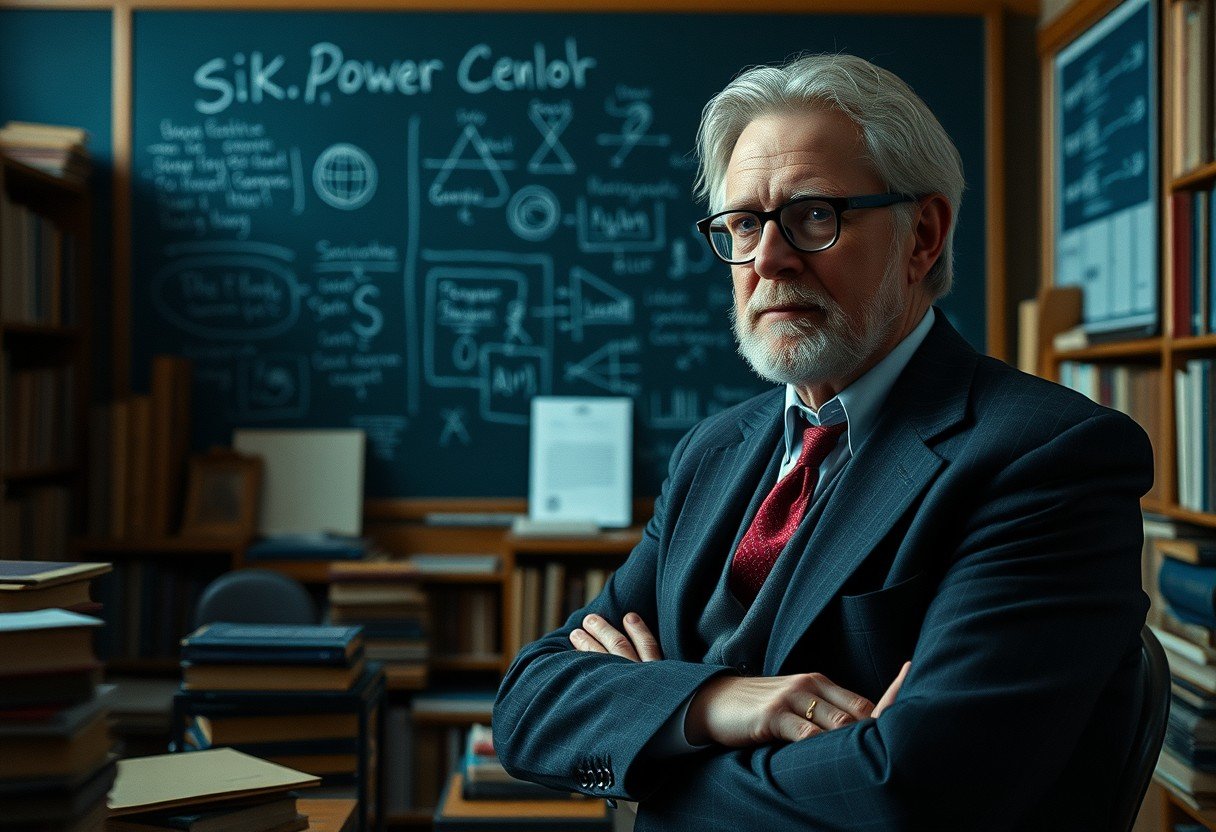Sociologist C. Wright Mills introduced the groundbreaking concept of the “power elite” in his 1956 book. He argued that a small, interconnected group of individuals from the top ranks of the military, corporate, and political worlds holds the most power in society. Understanding this theory helps explain how major national decisions are made, often without the public’s direct input, and how these choices shape our everyday lives from the economy to public policy.
Who was C. Wright Mills?
C. Wright Mills was a prominent and often controversial American sociologist. He was a professor at Columbia University and was known for his critical examination of modern society’s power structures.
He wasn’t just an academic who stayed in an ivory tower. Mills was a public intellectual who believed sociology should be used to understand and challenge the problems of the world. His work was driven by a concern for the loss of individual autonomy in a society increasingly dominated by large, impersonal institutions.
His book, “The Power Elite,” remains one of the most influential works in American sociology. It provided a powerful framework for analyzing who truly holds power, moving beyond the textbook explanations of democratic processes. Mills’ insights sparked decades of debate and research into the nature of power and inequality in the United States and beyond.
Breaking Down the Power Elite Theory
At its core, the Power Elite Theory suggests that power is not spread out among the people but is concentrated at the very top. Mills argued that the leaders of key institutions form a unified and dominant class.
He identified three primary domains where this power is centered. The leaders of these sectors often share similar social backgrounds, attend the same schools, and sit on each other’s boards, creating a cohesive and self-aware group.
This “interlocking directorate” allows them to coordinate policies that benefit their shared interests. The key components of the power elite include:
- The Political Leadership: This includes top officials in the executive branch of the federal government, not the scattered members of Congress.
- The Corporate Elite: The chief executives and major shareholders of the largest corporations who command the country’s economic resources.
- The Military Brass: The highest-ranking military officers and the Joint Chiefs of Staff, who influence foreign policy and defense spending.
Mills believed that these three groups are not separate entities but are interconnected, with individuals moving between these sectors throughout their careers. This creates a revolving door that further solidifies their shared worldview and power.
The Historical Roots of Mills’ Theory
Mills developed his theory during a specific period in American history: the post-World War II era. This context is crucial for understanding why he saw power becoming so concentrated. After the war, the United States emerged as a global superpower with a massive, permanent military establishment and a booming industrial economy.
This period saw the rise of what President Dwight D. Eisenhower would later call the “military-industrial complex.” The federal government grew enormously, and corporations became larger and more influential than ever before. Mills observed that these developments created a new social structure where decisions of immense consequence were made by a few.
He argued that historical events had centralized power in a way that was unprecedented. Before this period, power was more decentralized among various local and regional elites. However, the demands of a world war and a globalized economy fused the interests of military, corporate, and political leaders, forming the unified elite he described.
How the Power Elite Influences Your Daily Life
The concept of a power elite might seem abstract, but its influence can be seen in many aspects of daily life. The decisions made by this group can affect everything from your job prospects to the cost of groceries and the quality of news you consume.
For example, economic policies that favor large corporations, such as tax cuts or deregulation, are often shaped by the influence of the corporate elite. These policies can lead to greater wealth inequality, impacting the financial security of average families.
Similarly, decisions about war and peace are heavily influenced by the military and corporate sectors that profit from defense contracts. This can direct massive amounts of public funds toward military spending instead of education, healthcare, or infrastructure, affecting the services available in your community.
Even the information you receive is shaped by media conglomerates owned by a small number of powerful individuals. This can limit the diversity of viewpoints and create a public narrative that serves the interests of the elite.
Major Criticisms and Alternative Views
While highly influential, Mills’ Power Elite Theory is not without its critics. Some scholars argue that he oversimplified the nature of power in a complex society like the United States. They contend that power is not as unified or coordinated as Mills suggested.
The most prominent alternative perspective is known as pluralism. Pluralist theorists, like Robert Dahl, argue that power is distributed among many competing groups in society. These groups, which include unions, professional associations, and activist organizations, all vie for influence, preventing any single elite group from dominating completely.
According to pluralists, the political process is a negotiation among these diverse interests, and the government acts as a neutral referee. This view suggests that average citizens can exert influence by joining and supporting groups that represent their interests.
The table below summarizes the key differences between these two perspectives on power.
| Feature | Power Elite Theory (C. Wright Mills) | Pluralism Theory (Robert Dahl) |
|---|---|---|
| Power Distribution | Concentrated in a single, unified elite | Distributed among many competing groups |
| Source of Power | Control of major institutions (corporate, military, political) | Various resources (money, votes, organization) |
| Role of Government | Serves the interests of the elite | Acts as a neutral mediator between groups |
| Public Influence | Limited and largely manipulated | Exerted through interest groups and voting |
Is the Power Elite Still Relevant Today?
Decades after Mills published his work, the concept of the power elite remains incredibly relevant. Many contemporary observers argue that the trends Mills identified have only intensified. The concentration of wealth has reached historic levels, and the influence of money in politics is a major public concern.
Modern examples of a potential power elite can be seen in the figures who dominate the tech industry. Leaders of companies like Google, Meta, and Amazon wield enormous power over information, commerce, and communication, influencing public discourse and daily behavior on a global scale.
The “revolving door” between government and powerful industries like finance and defense contracting continues to operate. High-ranking officials often leave public service for lucrative positions in the private sector, raising questions about who they truly serve while in office.
By applying Mills’ framework, we can critically analyze current events and better understand the forces shaping our world. It encourages us to look beyond headlines and question who benefits from the major political and economic decisions of our time.
Frequently Asked Questions about the Power Elite
Who is the main theorist behind the Power Elite concept?
C. Wright Mills, an American sociologist, is the primary theorist who developed and popularized the concept of the Power Elite in his 1956 book of the same name.
What are the three parts of the Power Elite?
Mills identified three interconnected groups that form the elite: the top leaders of the political system, the corporate world, and the military establishment.
Is the Power Elite a conspiracy theory?
No, Mills did not present it as a secret conspiracy. He described it as a structural outcome where people in top institutional positions naturally come to share a common outlook and interests, leading them to act in concert without needing a secret plot.
How does the Power Elite theory differ from pluralism?
The Power Elite theory argues that power is concentrated in the hands of a small, unified group. In contrast, pluralism suggests that power is distributed among many competing interest groups, preventing any single group from dominating.
Why is Mills’ theory still important today?
The theory remains a vital tool for analyzing modern society, especially concerning issues like wealth inequality, corporate lobbying, and the influence of the military-industrial complex on government policy.









Leave a Comment